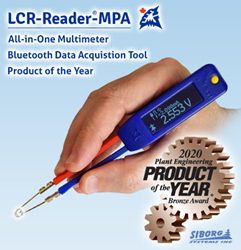
LCR-Reader-MPA won bronze in the Maintenance Tools and Equipment category for Plant Engineer’s Product of the Year 2020 contest.
Siborg’s All-in-One multimeter LCR-Reader-MPA has been placed 3rd for Plant Engineering’s Product of the Year 2020 in the Maintenance Tool and Equipment category.
WATERLOO, Ontario (PRWEB)
May 10, 2021
Siborg Systems Inc. entered their All-in-One multimeter LCR-Reader-MPA in Plant Engineering’s Product of the Year 2020 contest. Subscribers voted the product to win one of the winner’s places in the Maintenance Tools and Equipment category. Plant Engineering announced the place winners in April, with LCR-Reader-MPA winning the 3rd place bronze placement.
Plant Engineering is an online and offline magazine and source of news and products for production and maintenance. MPA went up against products from Exair, Des-Case Corp, and 2 products from Fluke Corp. in the Maintenance Tool and Equipment category.
LCR-Reader-MPA is a handheld digital multimeter with automatic LCR/ESR measurements, LED/Diode testing, oscilloscope mode, 100 kHz test frequency, AC/DC Voltage/Current meter, and more. The device simplifies testing with automatic measurements and no set-up between components. When a component is held between the gold-plated tweezer tips, the device will automatically determine the type of component and best test parameters to use – such as test mode, test frequency, etc. The device can also be set for specific measurements, different modes, open/short calibration and remove parasitic offsets. The ability to test with no set-up is an efficient tool for production lines and component sorting, where time is a premium.
LCR-Reader-MPA Features
- Automatic and manual LCR/ESR measurements
- 0.1% basic accuracy
- Test frequencies, 100, 120 Hz, 1, 10, 20, 30, 40, 50, 60, 75 and 100 kHz
- LED/Diode measurements
- Oscilloscope mode
- AC/DC Current/Voltage True Vrms measurements
- Signal generator
- Super Large Capacitance test up to 1 F
- 1.3 oz weight and ergonomic design
- Three test signal levels 0.1, 0.5 and 1 Vrms
A Bluetooth enabled model of LCR-Reader-MPA was released in the fall of 2020 that allows users to set custom measurement profiles and remotely record the measurement values into exportable tables. The companion program, LCR-MPA-BT Data Logger lets users set custom measurements profiles – a set of desired values that components must meet. Immediately after a measurement, the program will compare the desired values with the measured values and grants a Pass/Fail status, marking the recorded values green or red respectively. The ability to test and automatically Pass/Fail components is an exceptional tool for testing on a production line a varied amount of unknown components quickly and accurately.
Siborg offers their test equipment including Smart Tweezers and LCR-Reader as well as their accessories on Amazon in USA, Canada, and Europe; through their online store, the LCR-Reader Store and now through Digikey.
Siborg Systems Inc has been offering test equipment for SMT to the world’s electronics industry since they initiated the Smart Tweezers project in the early 2000’s. In 2013, they launched the LCR-Reader line of budget friendly LCR-meters. The device uses a lightweight multimeter with tweezers as probes and offer automatic testing with no set-up. By grasping a component between the tweezer tips, the device will determine the type of component and best test parameters are set for high accuracy measurements. The flagship LCR-Reader device offers a 0.5% basic accuracy wit ha price tag under $200, but only measures LCR and ESR values.
Since the launch of the LCR-Reader brand, Siborg has expanded its product line to include the Colibri, LCR-Reader-MP, LCR-Reader-MPA and LCR-Reader-MPA BT with Bluetooth connection. Siborg will be adding to the family with the 2021 summer launch of LCR-Reader-R2 which includes a 300 kHz test frequency, allowing for better accuracy while testing small inductances and capacitances.
Share article on social media or email:

